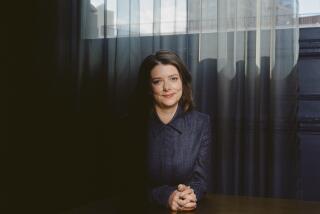Review: Barbara Loden’s 1970 triumph, ‘Wanda,’ returns to theaters
In an early scene from Barbara Loden’s landmark 1970 film, “Wanda,” the camera surveys a vast expanse of Pennsylvania coal country. In the distance, a pale speck of a woman appears and comes into focus, the camera zooming in on her as she makes her way across the black, hilly terrain.
Over the next 100 minutes or so, Loden, who plays the woman herself, will continue to close the distance between her character and the audience. We will get to know Wanda’s face, see her worth and understand some measure of her story, which is more than can be said of nearly anyone else in her midst.
Wanda has no money, no car, no job, no prospects. She does have a miner husband and two young kids, though we see her divesting herself of them early on at a divorce hearing. She tries to get work at a clothing factory, to no avail. She falls asleep at a movie theater, only to wake up and find she’s been robbed.
Most of Wanda’s nights end either at a bar, where she drinks and chats up a storm, or in bed with a stranger. Her latest catch, a brutish, bespectacled sort named Norman Dennis (Michael Higgins), turns out to be a robber on the lam and proceeds to lure her into perhaps the most pathetic Bonnie-and-Clyde scheme ever hatched.
To say that “Wanda” deglamorizes the American crime film is both entirely accurate and something of an understatement. Loden’s first and only film as a director is a searingly honest character study whose jagged, unvarnished aesthetic — inspired in part by Jean-Luc Godard’s “Breathless” and the films of Andy Warhol — stood in stark contrast to the slick Hollywood dramatic tradition epitomized by, among others, Loden’s husband, the director Elia Kazan.
Although “Wanda” won a major prize at the 1970 Venice International Film Festival, it drew a fairly indifferent reception when it opened in U.S. theaters the following year. It would be some time before its eventual reclamation as a masterpiece of independent cinema, a key feminist work and a forerunner of the politically and aesthetically adventurous New Hollywood cinema of the ’70s, with a particular stylistic connection to the raw, explosive psychodramas of John Cassavetes. (A UCLA Film & Television Archive restoration, which first screened in Los Angeles in 2011, will screen Saturday at the Aero Theatre and then Aug. 10-12 at the Egyptian Theatre.)
For seasoned art-house veterans viewing it today, “Wanda” may play like an engrossing if familiar piece of hard-scrabble realism, one whose legacy can be detected in the work of contemporary independent filmmakers such as Kelly Reichardt, Ramin Bahrani and the Dardenne brothers. But “realism” doesn’t entirely do justice to the world Wanda inhabits, which, for all the grit and grunge of its bars and diners and factory floors, is also a world of startling everyday beauty.
Shooting on grainy 16-millimeter reversal film (Nicholas Proferes served as cinematographer and editor), Loden finds a rich, textural poetry in the shafts of sunlight that can illuminate a sparsely furnished home and in the faded aquamarine wallpaper of the motel room where Dennis gives Wanda orders, insults and a hard slap on the face.
Loden was not exactly reluctant to point out the loose parallels between herself, with her impoverished North Carolina upbringing, and her much-neglected, much-abused heroine. In a 1971 interview with the New York Times, she said, “I came from a rural region, where people have a hard time. … They’re not concerned about anything more than existing from day to day.” Her film was thus a testament to a way of life that she herself had only narrowly escaped, when she moved to New York as a teenager and started her career as a dancer and pin-up model.
By the time Loden made “Wanda,” she was an actress with a Tony Award under her belt (for a 1964 Broadway production of “After the Fall”) and a number of film credits, two of them directed by Kazan (“Splendor in the Grass,” “Wild River”). What she achieved with her directorial debut was not just a radical vision of Middle America in economic and existential crisis, though that in itself would have been plenty. She also brilliantly challenged the industry’s stereotypes, its assumptions that she was just another beautiful Hollywood blonde rather than a restless, pioneering film artist.
The necessity of “Wanda,” a haunting portrait of social and psychological entrapment, is more than borne out by the still-pathetic dearth of opportunities for female directors in the American movie industry. It’s also borne out by Loden’s own embattled legacy: Her status as “Wanda’s” true auteur has come under intermittent fire over the years, even from Kazan, who claimed in an interview that he had written the movie’s script. That Loden never directed another picture before her death in 1980, and hardly for want of trying, is scarcely the least damning indictment left behind by this still-vital, astonishing movie.
------------
‘Wanda’
Running time: 1 hour, 43 minutes
Playing: Aero Theatre, Santa Monica (Saturday), and Egyptian Theatre, Hollywood (Aug. 10-12)
See the most-read stories in Entertainment this hour »
More to Read
Only good movies
Get the Indie Focus newsletter, Mark Olsen's weekly guide to the world of cinema.
You may occasionally receive promotional content from the Los Angeles Times.











